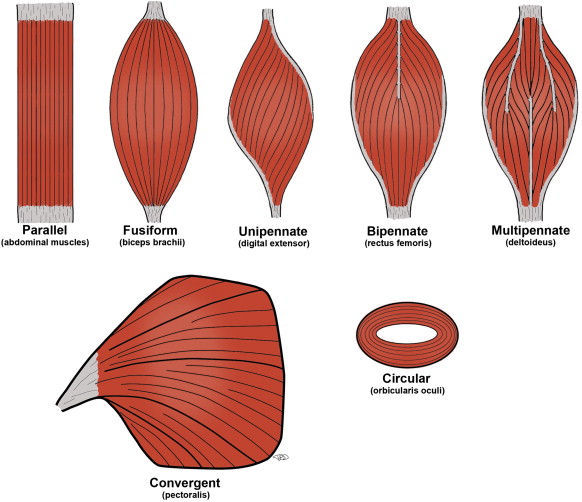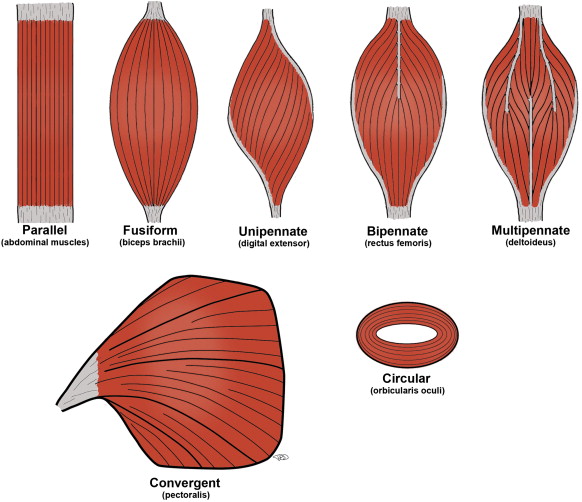biomechanics
1/47
There's no tags or description
Looks like no tags are added yet.
Name | Mastery | Learn | Test | Matching | Spaced |
|---|
No study sessions yet.
48 Terms
Basic muscle functions
Create movement
Maintain posture
Stabilize joints
Generate heat through contraction
Muscle properties
Contractillity: shorten
Extensibility: stretched beyond resting length
Elasticity: ability to return to resting length
Muscle nomenclature
Shape, size, number of heads, action, location, direction of fiber, attachment points.

Parallel muscle
Fibers run parallel to length of muscle
Great range of motion, less force

panate muscle
Fibers run at an angle to the tendon
Greater force less rom
Types of parallel muscles
Flat, fusiform, strap, radiate, sphincter
Types of pennate muscles
Unipennate: fibers on one side of tendon
Bipennate: fibers on both sides
Multipennate: several tendons with fibers
origin
proximal/stable attachment point
Insertion
Distal/movable attachment
Apineurosis
Flat, tendon like connective tissue
Retinaculum
Band that holds tendon in place
Fascia
Connective tissue surrounding muscles and groups
Muscle structure
Muscle-fascicle-muscle fiber-myofibrils-sarcomeres
Innervation
CNS
PNS
Force and velocity relationship
Faster contractions-less force
Eccentric contractions - greater force
Length and tension relationship
Optimal force at mid range muscle length
Isometric contraction
Muscle contracts but no movement
Stabilization
Concentric contraction
Muscle shortens, overcomes resistance
Acceleration
Eccentric contractions
Muscle lengthens under tension
Deceleration and control
muscle role: agonist
Prime mover ( main action )
Muscle role: antagonist
Opposes movement
Muscle roles: synergist
Assists agonist
Muscle role: neutralizer
Cancels unwanted motion
Muscle roles: stabilizer
Supports a joint
Muscle roles: force couple
Two+ muscles produce movement in the same direction
Proprioception
Body’s ability to sense position and movement
Kinesthesia
Awareness of motion itself
Muscle fiber type 1
Slow
High endurance
Posture
Muscle fiber type iia
Some endurance
Intermediate
Muscle type iix
High force quick fatigue
Explosive
Active insufficiency
Muscle cannot shorten enough to produce full range
Passive insufficiency
Opposing muscle too stretched to allow full rom
Lever class 1
A-R-F
Head neck
Balance
Levers class 2
A-R-F
Calf raise
Force advantage
Lever class 3
A-F-R
Bicep curl
Speed Rom advantage
Force arm
Distance from axis point of force application
Resistance arm
Distance from axis to resistance
Mechanical advantage
MA= force arm / resistance arm
MA > 1 more force
MA < 1 great speed and rom
Axis (A)
Pivot point or joint
Force (F)
Muscle effort applied
Resistance (R)
Weight or external load
Pulley
Change direction of force
Wheel and axle
Enhances force or speed
Law of inertia
Body stays at rest or motion unless acted upon
Law of acceleration
Force = mass x acceleration
Law of action
Every action has an equal and opposite reaction
Balance and stability
Balance: ability to control equilibrium
Stability: resistance to change in equilibrium